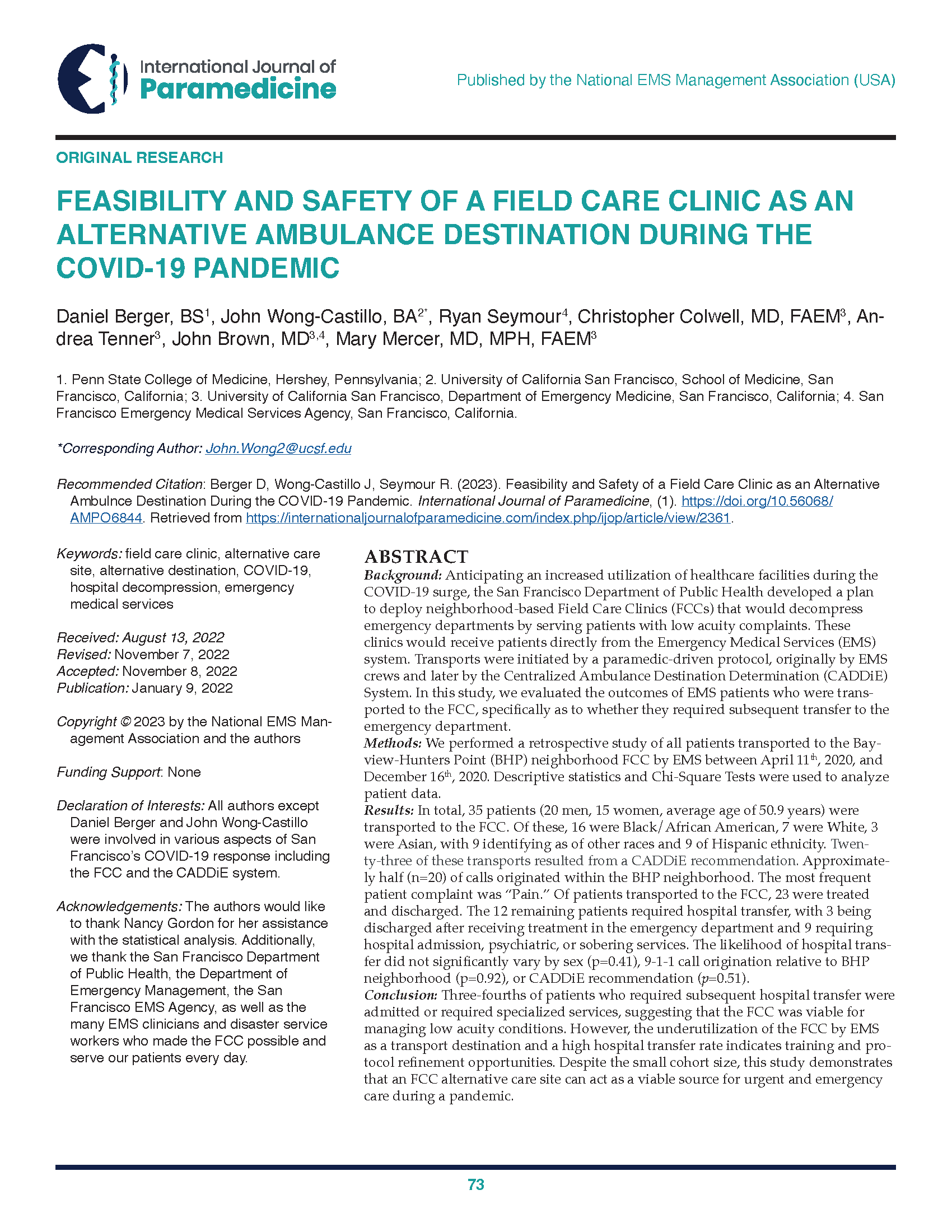Feasibility and Safety of a Field Care Clinic as an Alternative Ambulance Destination During the Covid-19 Pandemic
Main Article Content
Abstract
Background:
Anticipating increased volume on healthcare facilities during the COVID-19 surge, the San Francisco Department of Public Health developed a plan to deploy neighborhood-based Field Care Clinics (FCCs) that would decompress emergency departments by addressing low acuity complaints. These clinics would receive patients directly from the Emergency Medical Services (EMS) system. In this study, we evaluated the outcomes of EMS patients who were transported to the Bayview-Hunters Point (BHP) neighborhood FCC.
Methods:
We performed a retrospective study of all patients transported to the BHP FCC by EMS between 4/11/2020 and 12/16/2020. Descriptive statistics and Chi Square Tests were used to analyze patient data.
Results:
In total, 35 patients (20 men, 15 women, average age 50.9 years) were transported to the FCC. Of these, 16 were Black/African American, 7 White, 3 Asian, with 9 identifying as other races and 9 of Hispanic ethnicity. Approximately half (n=20) of calls originated within the BHP neighborhood. The most frequent patient complaint was “Pain.”
Of patients transported to the BHP FCC, 23 were treated and discharged. The 12 remaining patients required hospital transfer, with 3 patients subsequently discharged from the emergency department.
Conclusion:
Three-fourths of patients who required hospital transfer were admitted or required specialized services, suggesting that the FCC was able manage low acuity conditions. However, underutilization of the FCC by EMS as a transport destination and a high rate of hospital transfer indicates opportunities for training and protocol refinement.
Article Details

This work is licensed under a Creative Commons Attribution-ShareAlike 4.0 International License.
Publishing in IJOP allows authors to keep their copyright while giving IJOP unrestricted copyright permissions. Articles published in IJOP use Creative Common Attribution 4.0 International (CC BY-ND 4.0) licensing. This license requires that re-users give credit to the creator. It allows re-users to copy and distribute the material in any medium or format in unadapted form only, even for commercial purposes. Additional terms apply and can be accessed here.
Publishing in IJOP also allows authors to have contracts for non-exclusive distribution of the Journal's published version of the article, such as posting to an institutional repository or publication in a book, on the condition that the original publication in the original layout format in IJOP is retained and acknowledged.
We permit and encourage authors to post the articles they published in IJOP on their affiliated websites. This helps share the information, encourages citation in other works, and promotes scholarly discourse in the spirit of open access.
References
Bayview & Hunters Point PUMA, CA | Data USA. (n.d.). Retrieved May 29, 2022, from https://datausa.io/profile/geo/bayview-hunters-point-puma-ca
Blodgett, J. M., Robertson, D. J., Pennington, E., Ratcliffe, D., & Rockwood, K. (2021). Alternatives to direct emergency department conveyance of ambulance patients: A scoping review of the evidence. Scandinavian Journal of Trauma, Resuscitation and Emergency Medicine, 29(1), 4. https://doi.org/10.1186/s13049-020-00821-x
Census profile: San Francisco County (South Central)--Bayview & Hunters Point PUMA, CA. (n.d.). Census Reporter. Retrieved May 29, 2022, from http://censusreporter.org/profiles/79500US0607507-san-francisco-county-south-central-bayview-hunters-point-puma-ca/
City and County of San Francisco. (n.d.). COVID-19 Case Maps | San Francisco. San Francisco Neighborhood Maps of COVID-19 Case Rates. Retrieved April 28, 2022, from https://sf.gov/data/covid-19-case-maps#total-cases-map
Creed, J. O., Cyr, J. M., Owino, H., Box, S. E., Ives-Rublee, M., Sheitman, B. B., Steiner, B. D., Williams, J. G., Bachman, M. W., Cabanas, J. G., Myers, J. B., & Glickman, S. W. (2018). Acute Crisis Care for Patients with Mental Health Crises: Initial Assessment of an Innovative Prehospital Alternative Destination Program in North Carolina. Prehospital Emergency Care: Official Journal of the National Association of EMS Physicians and the National Association of State EMS Directors, 22(5), 555–564. https://doi.org/10.1080/10903127.2018.1428840
Goei, A., & Tiruchittampalam, M. (2020). Community Care Facility-A Novel Concept to Deal With the COVID-19 Pandemic: A Singaporean Institution’s Experience. Journal of Public Health Management and Practice: JPHMP, 26(6), 613–621. https://doi.org/10.1097/PHH.0000000000001257
Gregg, M., Blanchfield, B., Richard M., B., Mountford, J., & Vanderwagen, C. (2020). Alternative Care Sites for the Covid-19 Pandemic: The Early U.S. and U.K. Experience. NEJM Catalyst Innovations in Care Delivery. https://catalyst.nejm.org/doi/full/10.1056/CAT.20.0224
Harrison, R., Chauhan, A., Le-Dao, H., Minbashian, A., Walpola, R., Fischer, S., & Schwarz, G. (2022). Achieving change readiness for health service innovations. Nursing Forum, 57(4), 603–607. https://doi.org/10.1111/nuf.12713
Khanijahani, A., Iezadi, S., Gholipour, K., Azami-Aghdash, S., & Naghibi, D. (2021). A systematic review of racial/ethnic and socioeconomic disparities in COVID-19. International Journal for Equity in Health, 20(1), 248. https://doi.org/10.1186/s12939-021-01582-4
Khaw, K. W., Alnoor, A., AL-Abrrow, H., Tiberius, V., Ganesan, Y., & Atshan, N. A. (2022). Reactions towards organizational change: A systematic literature review. Current Psychology (New Brunswick, N.j.), 1–24. https://doi.org/10.1007/s12144-022-03070-6
Magesh, S., John, D., Li, W. T., Li, Y., Mattingly-App, A., Jain, S., Chang, E., & Ongkeko, W. (2021). Disparities in COVID-19 Outcomes by Race, Ethnicity, and Socioeconomic Status: A Systematic-Review and Meta-analysis. JAMA Network Open, 4(11). https://doi.org/10.1001/jamanetworkopen.2021.34147
Morganti, K. G., Alpert, A., Margolis, G., Wasserman, J., & Kellermann, A. L. (2014). Should payment policy be changed to allow a wider range of EMS transport options? Annals of Emergency Medicine, 63(5), 615-626.e5. https://doi.org/10.1016/j.annemergmed.2013.09.025
Pointer, J. E., Levitt, M. A., Young, J. C., Promes, S. B., Messana, B. J., & Adèr, M. E. (2001). Can paramedics using guidelines accurately triage patients? Annals of Emergency Medicine, 38(3), 268–277. https://doi.org/10.1067/mem.2001.117198
Sawyer, N. T., & Coburn, J. D. (2017). Community Paramedicine: 911 Alternative Destinations Are a Patient Safety Issue. Western Journal of Emergency Medicine, 18(2), 219–221. https://doi.org/10.5811/westjem.2016.11.32758
Schaefer, R. A., Rea, T. D., Plorde, M., Peiguss, K., Goldberg, P., & Murray, J. A. (2002). An emergency medical services program of alternate destination of patient care. Prehospital Emergency Care: Official Journal of the National Association of EMS Physicians and the National Association of State EMS Directors, 6(3), 309–314. https://doi.org/10.1080/10903120290938355
Smith-Bernardin, S. M., Kennel, M., & Yeh, C. (2019). EMS Can Safely Transport Intoxicated Patients to a Sobering Center as an Alternate Destination. Annals of Emergency Medicine, 74(1), 112–118. https://doi.org/10.1016/j.annemergmed.2019.02.004

